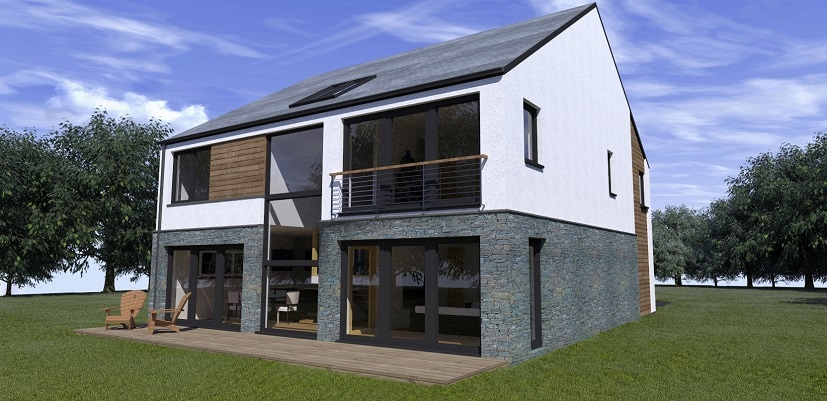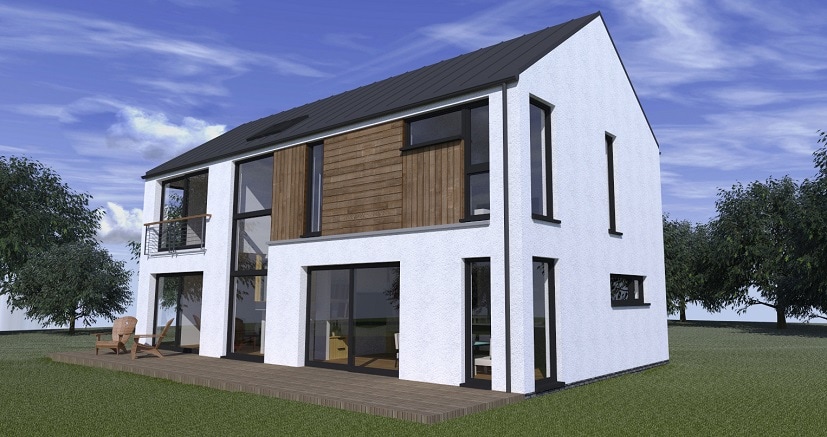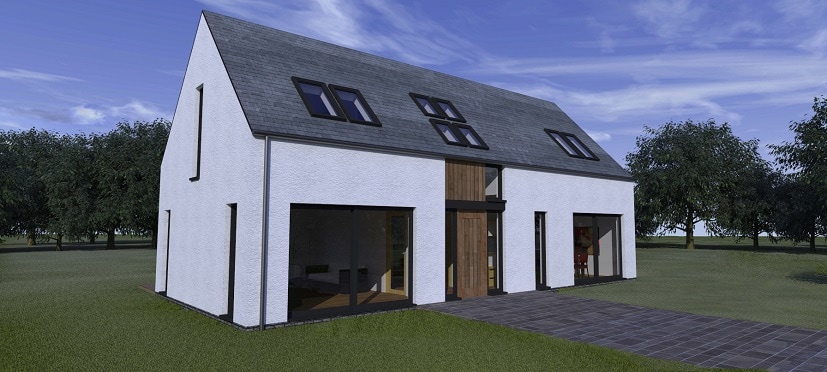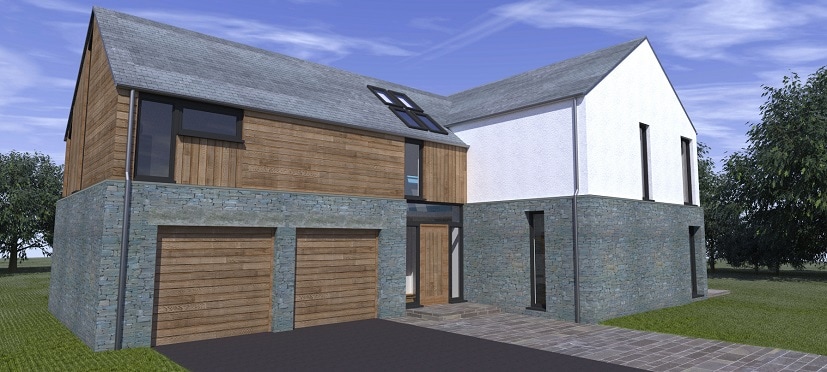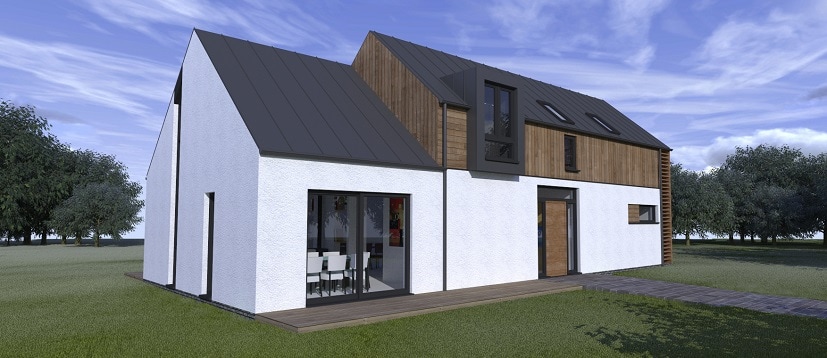Fixed Cost Self-build Homes
We have created a range of architect-designed homes that provide clients with a fixed cost for design, planning applications and building standards approval.
Andrew Black Design will provide you with a unique, professional Architects service, covering the following 3 separate services for a fixed cost;
Stage 1: Design choices, options and planning application.
Stage 2: Building Warrants and technical approvals.
Stage 3: Site inspections for mortgage purposes.
All the above stages are carried out for a fixed fee agreed prior to starting the project, giving the client upfront costs to allow them to budget accurately.
Home designs
These contemporary homes are designed by our team of award-winning Architects.
Just choose the house design that suits you best.
Frequently asked questions
Building your home doesn’t have to be complicated and we have an answer for nearly every question. The simple nature of our process will avoid many of the dilemmas and problems associated with the normal self-build housing route.
We have an experienced team of architects and architectural technicians and will be able to answer most of your questions or point you in the right direction. The information on this site will give you a good starting point, but if you can’t find the answer don’t hesitate to contact us.
Can I change the design?
The various house types will hopefully give everyone the house size and style they need and are designed with this in mind.
Minor changes can usually be made to the design without changing the fundamental structure, although sometimes changes become too significant and we will need to re-engineer the structure, so we would try and avoid too many changes.
We charge a basic additional hourly rate to change designs and have them checked by our engineer, and as always, we inform you of the likely costs before proceeding.
Planning in Principle
This is a basic form of the normal full planning approval and covers the principle of the development rather than the detail. The local authority will assess the development against policy rather than the actual look of the proposals.
It is becoming more and more common for local authorities to ask for details such as drainage to be confirmed at this stage and as such is not as straight forward an application as it previously had been.
It is preferred that when buying a plot that at least outline planning approval is in place, but this is not essential. We can carry out a ‘Planning in Principle’ application for you, for a reduce cost, if the chances of approval are not certain.
Detailed Planning Approval
Full planning permission is required before proceeding to Building Warrant Approval. A full application can be made, sometimes referred to as a Reserved Matters Application when following a ‘Planning in Principle’ consent.
Detailed plans, elevations, sections, site plans, location plans and design statement accompany the application, providing enough information to allow the local authority to assess the proposals. All the above is carried out by Andrew Black Design on your behalf as part of Stage 1. See details.
Building Standards Approval
An application must be made for new buildings in Scotland under the Building (Scotland) Regulations. The application is made to the relevant local authority and covers details of items such as wall, roof & floor construction, structure, drainage, insulation and heating.
We do this for you, preparing the drawings and specification and making the building standards application for you. We do all the negotiations with the building standards officers, we organise the Structural Engineers SER certificate for the whole project, which covers the foundations, exterior beams and lintols and the timber structure, including the roof trusses.
Do we sell kits only?
Unfortunately not, but you are free to use our drawings to send out to timber kit companies, who can provide you with a competitive quote for the supply of the kit. Alternatively, your contractor may be able to organise this direct, which has advantages for VAT purposes.
Value Added Tax
New build houses are normally zero-rated by HMRC. You normally require using a Main Contractor to avoid paying VAT up front. If you use separate trades, you can usually claim the VAT back following the guidelines from HM Customs & Excise at this link or contact your accountant or tax professional for further advice.
VAT is unfortunately charged on our professional fees regardless of the zero rating of actual build, in line with all professional services related to building.
SER Structural Certificate
This can only be issued by an engineer who is an Approved Certifier of Design (Building Structures). This certificate is issued with the application to Local Authorities for Building Standards Approval and ensures that all aspects of design of the structure of a project satisfy the requirements of the Building (Scotland) Regulations. This will include the kit structure and elements like the foundations, exterior lintols and the staircase. We organise this for you, and this cost is included within the Stage 2 fee. See details.
Who do I get to build my house?
The actual builder of your home will be the key to the success of your project. The decision to appoint a contractor should be based on thorough research of potential candidates and should include details of similar previous projects and references, current workload, suitable insurance cover and key sub-contractors.
A NHBC registered builder or membership of suitable organisations such as Federation of Master Builders is helpful, but relevant referrals are usually the most important. We don’t usually recommend carrying out a building project without any professional inspections, unless you are relatively experienced and have a good knowledge of the contractor.
The most important part of any construction relationship is the contract and agreement between you. Always use a contract, which states the cost, payment frequency, retention sums, what is included and not included and dispute resolution procedures. We suggest you use a standard homeowners contract if you aren’t using a professional and these can be obtained from SBCC online.
We offer to refer you to a small list of preferred builders who we have worked with in the past. We also suggest that you take suitable advice prior to appointing any builder and have a third-party professional to inspect the works on your behalf.
Inspections for Mortgage Purposes
You may need to organise some form of inspection to satisfy your mortgage company the works have been carried out to a suitable standard.
Architects can supply an Inspection Certificate or Council of Mortgage Lenders Certificate (CML) if they inspect the works at various key intervals throughout the build process.
A CML certificate is not a warranty, so if you need a higher level of cover, you can use a warranty service such as NHBC or Zurich, which offer self-build covers.
We can carry out this service for you as detailed in Section 3. Alternatively, when the location makes our service uneconomical, a suitable one can be found by contacting the RIAS – www.rias.org.uk
The above cover does not prevent small defects and doesn’t deal with contractual disputes, so make sure you get suitable professional advice on the actual build.
Timber Frame Construction
We normally use tried and tested timber frame technology, avoiding some of the more complicated alternatives that are still proving to be problematic. Engineered to high levels of accuracy and quality, the system allows speedy construction.
Now used in over 75% of new homes in Scotland, the skills are readily available to make the most of this efficient building process. Using timber from managed forests, timber kits are by far the most environmentally friendly way to build.
Some of the key benefits:
- Significantly simplifies on-site construction
- Allows speedy construction to wind & watertight reducing costs
- High levels of insulation easily integrated
- Off-site manufacture leads to greater control and quality
Energy Efficient Homes
We appreciate that energy use and its resultant cost is a major factor for most self-builders. Further to this our designs allow integration of many alternative energy saving technologies and offer the option to upgrade insulation levels and specification.
Timber kits allow the use of the highest efficiency insulation materials and reflective breather membranes, meaning walls can exceed current building regulation. We also make the most of Accredited Construction Details, issued by the Scottish Government, when followed correctly, allow the reduction of air leakage in the building, reducing heating and energy bills substantially.
Preparing energy calculations such as SAP and U-values in house, allows us to design our houses around the whole energy use of the building, rather than just individual elements. We can then take in to account the heating, lighting, solar gain and heat loss to ascertain the actual energy use and co2 created.
Our house designs will allow the easy integration of various alternative technologies. Whether you are planning a heat pump from water, ground or air sources, our floor constructions can be altered easily to allow underfloor heating to be used, the most efficient use of heat pump technology.
Finding a plot and getting finance
Getting Finance
Getting finance can be the biggest stumbling block to getting started in self-build. Even in the current financial climate, there are many options available.
Specialist mutual building societies such as the Ecology Building Society are set up to offer finance to self-builders who have an ecological basis to their project. They even give you discounts when you incorporate more energy-saving and renewable technologies.
Websites like Buildstore also have finance sections that will search for suitable self-build mortgage companies on your behalf instead of trying to search for various websites.
Finally, the high street banks and building societies are better set up these days to offer a range of suitable products and should not be discounted. There may be a solution at your own branch.
Finding a Plot
Dedicated Websites
There are now many websites that collate plots for sale, doing the work for you. Sign up and they will let you know when one comes up in your area. The following links are just some of the options;
www.buildstore.co.uk
www.plotfinder.net
www.uklanddirectory.org.uk
www.plotbrowser.com
Estate Agents & Solicitors
Use the local Solicitors Property Centre Guide. Most areas have a guide which will be in paper form and website based. They are updated regularly and often have plots for sale with outline approval.
Most Estate agents & Solicitors will put you on their database and update you when suitable plots become available. This sometimes gets you in before plots go to market.
There are now several web only based estate agents who will list land not in the local property centres.
www.zoopla.co.uk
www.s1homes.com
www.rightmove.co.uk
Existing Developments
Don’t be afraid to contact the developer of existing housing developments, as they often are open to selling off remaining plots to fund new projects or just minimise their current exposure. These can be worth a little extra money as you may be able to tap into their service connections and permissions.
Know your target area
Get out of the car and have a look around. Speak to the locals and identify sites that may be available and ask. Ordnance Survey maps are great for getting a birds-eye view, as is google earth, and you can target plots that others might not see.

